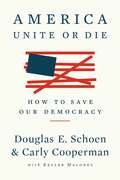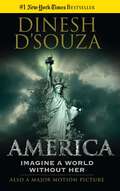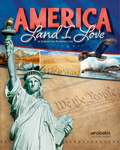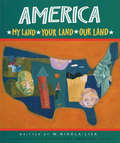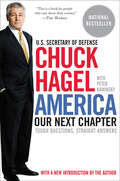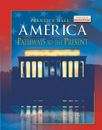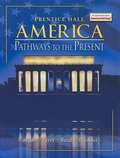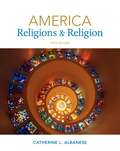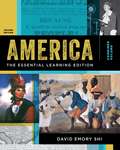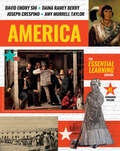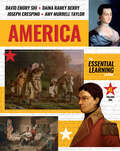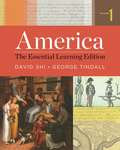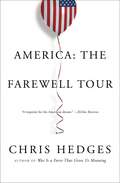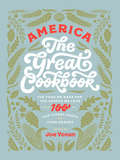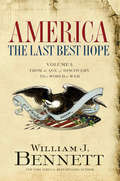- Table View
- List View
America: How to Save Our Democracy
by Douglas E. Schoen Carly CoopermanWHAT AMERICA MUST DO TO ACHIEVE UNITY AND SAVE OUR DEMOCRACY AMERICA: UNITE OR DIE is a real-time analysis of why American Democracy is crumbling and why both sides – Republicans and Democrats – are responsible for its collapse. This is the first objective, nonpartisan analysis of what has happened, and most importantly, explains what we can do to avoid impending doom for our system, and most of all, our nation. ONE NATION, INDIVISIBLE? America is the only country in the history of the world founded on an idea—and that idea is liberty. It&’s an idea that resulted in the most flourishing citizenry in human history, but today that idea is under attack, not just from foreign adversaries but from within as the extreme right of the Republican Party and extreme left of the Democratic Party move further and further apart. These dangerous, corrosive positions pose a serious threat to the foundations of American democracy as we now face: · A political class that has lost touch with mainstream America. · Public loss of trust in the institutions of democracy. · The rise and mobilization of extremism on the right and left, both threatening violence. · The rise of social media, websites, and cable TV news that splinters audiences and creates alternate realities. · Inequality of opportunity that creates a two-tiered society of haves and have-nots. · Anti-democratic regimes ruling China and Russia that threaten freedom around the world. In an era of growing distrust, demonization, and hatred, as we live America&’s tragic &‘Tale of Two Cities,&’ our most inspired turn is to embrace the idea engendered in a true symbol of American democracy: the mighty woman with a torch, &‘the Statue of Liberty Enlightening the World&’: &“Give me your tired, your poor/ Your huddled masses yearning to breathe free&”. When citizens who work hard and play by the rules believe they have no shot at the American Dream — or conclude that the American values, identity, and the principles they grew up with are vanishing — a giant question mark hangs over the future of our democracy. If we hope to preserve our democracy, both sides must start by reaffirming their belief in the democratic principles of America so they can move from the fringes to the moderate middle-of-the-road positions that millions of Americans embrace. AMERICA: UNITE OR DIE is an inspired plan to turn the Divided States of America into the Reunited State of America. &“America: Unite or Die is a must-read for anyone interested in politics and governing or in the current dysfunction of our political system. Douglas Schoen and Carly Cooperman are great scholars and practitioners of American politics. They are two of the country's finest pollsters and strategists who have seen it all—from advising presidents in the White House to analyzing the voters in the precincts across America. The polarization in this country today is explained clearly. Every citizen who cares about this extraordinary country of ours should read this book and be enlightened about what's going on around them.&” —Ed Rollins, former assistant to President Reagan for political and governmental affairs, and former co-chairman to the National Republican Congressional Committee
America: Imagine a World without Her
by Dinesh D'Souza#1 New York Times BestsellerIs America a source of pride, as Americans have long held, or shame, as Progressives allege? Beneath an innocent exterior, are our lives complicit in a national project of theft, expropriation, oppression, and murder, or is America still the hope of the world?Dinesh D'Souza says these questions are no mere academic exercise. It is the Progressive view that is taught in our schools, that is preached by Hollywood, and that shapes the policies of the Obama administration. If America is a force for inequality and injustice in the world, its power deserves to be diminished; if traditional America is based on oppression and theft, then traditional America must be reformed-and the federal government can do the reforming.In America: Imagine a World without Her D'Souza offers a passionate and sharply reasoned defense of America, knocking down every important accusation made by Progressives against our country.Provocative in its analysis, stunning in its conclusions, Dinesh D'Souza's America will be the most talked about book of the year.
America: Independence Through 1914, California
by Michael B. Stoff James West DavidsonThis illustrated edition enlightens students on topics, divided into six units, covering Foundations of American History, The Constitution of the United States, The New Republic, The Nation Expands and Changes, Civil War and Reunion, and An Age of Industry.
America: Land I Love
by Kurt A. Grussendorf D.A.; Michael R. Lowman D.A.; Brian S. AshbaughAmerica: Land I Love presents a chronological account of American history with a factual emphasis on the people and events that shaped the United States. Incorporated throughout are thought-provoking questions to develop critical thinking skills and a biblical worldview regarding the significance of individuals and events in the nation’s history. This text highlights America’s heritage of faith and her patriotic pursuit of freedom as foundational values in the history of the United States of America.
America: Land I Love
by Kurt A. GrussendorfThe people were living in the New World long before the Europeans discovered it. Over four thousand years ago, after the great Flood of Noah's day, God caused the people of the world to speak many different languages and scattered them from the tower of Babel "upon the face of all the earth."
America: Modern American History
by Andrew Cayton Elisabeth Israels Perry Linda Reed Allan M. WinklerTextbook on modern American history.
America: Modern American History
by Andrew Cayton Elisabeth Israels Perry Linda Reed Allan M. WinklerThe book covers American history in several chapters. Each chapter covers timelines, summarizing the main idea question, organizing information activity, critical thinking questions, writing activity and historical events.
America: My Land, Your Land, Our Land
by W. Nikola-Lisa<p>America is made up of opposites: Our land boasts majestic high mountains and vast lowlands. America is also a land of contrasts: We are a rich nation, yet so many are poor. The America of this book, rendered with imagination and vision by 14-outstanding artists from diverse backgrounds, is the America that our children see around them. America: My Land, Your Land, Our Land is a visual celebration of America and a challenge to our children to cherish it, because they will one day inherit it. <p>Guided Reading: E <p>Lexile: NP <p>Interest Level: Grades K - 4 <p>Reading Level: Grades 2 - 2 <p>Themes: Comparing/Classifying/Measuring, Nature/Science, United States History, Identity/Self Esteem/Confidence, Responsibility, Neighbors, Native American Interest, Muslim/Muslim American Interest, Multiethnic interest, Latino/Hispanic/Mexican Interest, Home, History, Environment/Nature, Cultural Diversity, African/African American Interest, Asian/Asian American Interest, Exploring Ecosystems, Human Impact On Environment/Environmental Sustainability , Respect/Citizenship, Pride
America: Our Next Chapter
by Peter Kaminsky Chuck HagelSenator Chuck Hagel has long been admired by his colleagues on both sides of the Senate floor for his honesty, integrity, and common-sense approach to the challenges of our times. The Los Angeles Times has praised his "bold positions on foreign policy and national security" and wondered, "What's not to like?" In America: Our Next Chapter, Nebraska-born Hagel offers a hard-hitting examination of the current state of our nation and provides substantial, meaningful proposals that can guide America back onto the right path. In America: Our Next Chapter, Hagel speaks the truth as he sees it—in a direct and refreshingly unvarnished manner. Basing his suggestions on thorough research and careful thought, as well as on personal insight from his years as a political insider, successful businessman, and decorated war hero, he discusses domestic issues—including the health care crisis, immigration, and Social Security and Medicare reform—and global climate change. He confronts foreign policy problems that the current administration has bungled or ignored, including China's growing economy; control of U.S. debt; India's and Pakistan's nuclear capabilities; and Iran's aggressive political, ideological, and nuclear stances. He decries the pervasive disease of third world poverty, arguing convincingly that this is where the real fight against terrorism must begin. Always true to the beliefs instilled in his childhood on the prairie, he speaks passionately about service—to one's country and to one's fellow citizens—as the path toward a renewed America. And, of course, he gives a candid examination of the debacle that is the Iraq War. A staunch Republican yet a "hero to liberals" (Time), Hagel asks the tough questions and delivers straight answers to America's most pressing problems. America: Our Next Chapter is a serious, honest, and, ultimately, optimistic look at our nation's future, from an American original.
America: Pathways To The Present
by Andrew Cayton Elisabeth Israels Perry Linda Reed Allan M. WinklerMuch of American history can be better understood if events are viewed as part of a larger pattern. The themes and features throughout this book identify the larger patterns and the connections between events across time.
America: Pathways To The Present
by Andrew Cayton Linda Reed American Heritage Publishing Staff Elisabeth Perry Allan WinklerThis volume focuses on the events from the Civil War through today. The text includes a substantive review unit early American history to facilitate a quick, effective start to the study of modern times.
America: Pathways to the Present
by Andrew Cayton Elisabeth Israels Perry Linda Reed Allan M. WinklerA concise book on the history of America covering the period from the Origins of a New Society to 1754, Balancing Liberty and Order, 1753-1820, An Emerging New Nation, 1783-1855, Division and Uneasy Reunion, 1846-1877,Expansion: Rewards and Costs, 1850-1915,The United States on the Brink of Change, 1890-1920, Boom Times to Hard Times, 1920-1941, Hot and Cold War, 1931-1960, A Period of Turmoil and Change, 1950-1975,and Continuity and Change, 1969 to the Present.
America: Pathways to the Present
by Andrew Cayton Elisabeth Israels Perry Allan M. WinklerThis book provides in-depth, balanced content covering the beginnings of U.S. history through the present.
America: Pathways to the Present (Survey Edition)
by Andrew Cayton Elisabeth Israels Perry Linda Reed Allan M. WinklerHistory textbook.
America: Religions and Religion (5th Edition)
by Catherine L. AlbaneseAlbanese (emerita, comparative religions, U. of California--Santa Barbara) introduces students to the variety of religions in the US, and to the theories and practices of studying religion. She considerably shortened and revised the 2007 fourth edition to account for changes in classes and students, and for this fifth takes account of changes in the religious landscape since then--including findings from the 2010 census. She covers the original cast, new-made in America, patterns of expansion and contraction, and American religion and American identity. Among specific topics are tradition and change among Native Americans, the presence of Roman Catholicism, the protestant churches and the mission mind, African American religion and nationhood, 19th-century new religions, Eastern peoples and Eastern religions, and many centers meeting.
America: The Essential Learning Edition
by David E. ShiLively yet concise, The Essential Learning Edition of America blends Shi and Tindall s unrivalled narrative style with innovative pedagogy to help students understand major historical developments and strengthen critical interpretive skills. Online adaptive learning tools enhance and assess students mastery of the core objectives from the text."
America: The Essential Learning Edition (Fourth Edition) (Vol. Combined Volume)
by David E. Shi Daina Ramey Berry Joe Crespino Amy Murrell TaylorA best-selling narrative history enters a new generation The beloved and best-selling America: A Narrative History family of books has been used by millions of students because of its enthralling storytelling that brings history to life. Award-winning teachers and scholars Daina Ramey Berry (University of California, Santa Barbara), Joseph Crespino (Emory University), and Amy Murrell Taylor (University of Kentucky) join lead author David Shi (Furman University) to enhance the balanced narrative with a focus on the diverse experiences of women in American history. Seamlessly integrated into the reading experience, new tools help students to read at the college level and engage with the building blocks of history: primary sources. This purchase offers access to the digital ebook only.
America: The Essential Learning Edition (Fourth Edition) (Vol. Volume 1)
by David E. Shi Daina Ramey Berry Joe Crespino Amy Murrell TaylorA best-selling narrative history enters a new generation The beloved and best-selling America: A Narrative History family of books has been used by millions of students because of its enthralling storytelling that brings history to life. Award-winning teachers and scholars Daina Ramey Berry (University of California, Santa Barbara), Joseph Crespino (Emory University), and Amy Murrell Taylor (University of Kentucky) join lead author David Shi (Furman University) to enhance the balanced narrative with a focus on the diverse experiences of women in American history. Seamlessly integrated into the reading experience, new tools help students to read at the college level and engage with the building blocks of history: primary sources. This purchase offers access to the digital ebook only.
America: The Essential Learning Edition (Fourth Edition) (Vol. Volume 2)
by David E. Shi Daina Ramey Berry Joe Crespino Amy Murrell TaylorA best-selling narrative history enters a new generation The beloved and best-selling America: A Narrative History family of books has been used by millions of students because of its enthralling storytelling that brings history to life. Award-winning teachers and scholars Daina Ramey Berry (University of California, Santa Barbara), Joseph Crespino (Emory University), and Amy Murrell Taylor (University of Kentucky) join lead author David Shi (Furman University) to enhance the balanced narrative with a focus on the diverse experiences of women in American history. Seamlessly integrated into the reading experience, new tools help students to read at the college level and engage with the building blocks of history: primary sources. This purchase offers access to the digital ebook only.
America: The Essential Learning Edition, Volume 1
by George Brown Tindall David E. Shi Erik Anderson Jonathan LeeLively yet concise, The Essential Learning Edition of America blends Shi and Tindall's unrivalled narrative style with innovative pedagogy to help students understand major historical developments and strengthen critical interpretive skills. Online adaptive learning tools enhance and assess students' mastery of the core objectives from the text.
America: The Farewell Tour
by Chris HedgesA profound and provocative examination of America in crisis, where unemployment, deindustrialization, and a bitter hopelessness and malaise have resulted in an epidemic of diseases of despair—drug abuse, gambling, suicide, magical thinking, xenophobia, and a culture of sadism and hate.America, says Pulitzer Prize–winning reporter Chris Hedges, is convulsed by an array of pathologies that have arisen out of profound hopelessness, a bitter despair and a civil society that has ceased to function. The opioid crisis, the retreat into gambling to cope with economic distress, the pornification of culture, the rise of magical thinking, the celebration of sadism, hate, and plagues of suicides are the physical manifestations of a society that is being ravaged by corporate pillage and a failed democracy. As our society unravels, we also face global upheaval caused by catastrophic climate change. All these ills presage a frightening reconfiguration of the nation and the planet. Donald Trump rode this disenchantment to power. In America: The Farewell Tour, Hedges argues that neither political party, now captured by corporate power, addresses the systemic problem. Until our corporate coup d’état is reversed these diseases will grow and ravage the country. A poignant cry reported from communities across the country, America: The Farewell Tour seeks to jolt us out of our complacency while there is still time.
America: The Great Cookbook
by Joe YonanA diverse collection of home cooking recipes from America&’s top chefs, including David Chang, Rick Bayless, Nathalie Dupree, and many more. The James Beard Award-winning Food & Dining editor of The Washington Post, Joe Yonan asked a hundred of America&’s best chefs, artisan producers, and food personalities a personal question: What do you love to cook for the people that you love? Their answers comprise this unique cookbook—the ultimate celebration of contemporary American cuisine in all its glorious diversity. From well-known chefs and TV personalities like Buddy Valastro and Carla Hall to culinary revolutionaries such as Michael Voltaggio and Dan Barber, these great American culinary heroes share their most treasured home recipes. Lavishly photographed with spectacular images of food and locations from across the United States, this gorgeous cookbook highlights the very best of American food.
America: The Last Best Hope (Volume I)
by William J. BennettTo resce the future, we must remember our past.With command and wit, William J. Bennett reacquaints Americans with their heritage in an engaging narrative that cuts through the cobwebs of time, memory, and prevailing cynicism. Washington, Franklin, Lincoln, Roosevelt, and others reemerge not as marble icons or dust-dry names in a textbook, but as full-blooded, heroic pioneers whose far-reaching vision forged a nation that attracted?that still attracts?millions yearning to breathe free. In this, the first volume of a "reasoned, balanced presentation of the American story," Bennett tells our nation's story, with all its triumphs and tragedies. He summons us to embrace America's cause once again as "the last best hope of earth."What others are saying:"William J. Bennett artfully and subtly makes connections between our past and current events, reminding us ... that we are intimately and immediately connected to the extraordinary Americans who have bestowed upon us our great heritage.... [T]he importance of America: The Last Best Hope probably exceeds anything Dr. Bennett has ever written, and it is more elegantly crafted and eminently readable than any comprehensive work of history I've read in a very long time. It's silly to compare great works of history to great novels, but this book truly is a page-turner.... Prepare to have your faith in, hope for, and love of America renewed." -Brad Miner, American Compass"The Role of history is to inform, inspire, and sometimes provoke us, which is why Bill Bennett's wonderfully readable book is so important. He puts our nation's triumphs, along with its lapses, into the context of a narrative about the progress of freedom. Every now and then it's useful to be reminded that we are a fortunate people, blessed with generations of leaders who repeatedly renewed the meaning of America." -Walter Isaacson, Benjamin Franklin: An American Life"For too long Americans have been looking for a history of our country that tells the story of America's triumphs as well as its tragedies. Now Bill Bennett has come forward with America: The Last Best Hope, which tells the story-fairly and fully-from 1492 to 1914. Americans who have been reading recent biographies of the Founding Fathers will love this book." -Michael Barone, US News & World Report"Bill Bennett's book will stand as perhaps the most important addition to American scholarship at this, the start of the new century. For the past fifty years American historians have either distorted American history or reduced it to a mess of boring indictments of our cultural and political heritage. With this book Bennett offers to Americans young and old an exciting and enjoyable history of what makes America the greatest nation on earth. -Brian Kennedy, president, The Claremont Institute
